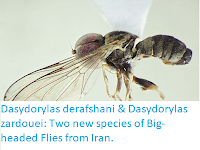Inbiomyiid Flies are a curious group of True Flies, Dipters, first discovered in 2006. They are small in size, with the largest recorded specimens being about 1.6 mm in length, and generally very dark in colour. Inbiomyiid Flies are restricted to the tropical forests of the Americas but little is known about their biology. Large, flattened eggs have been found within the bodies of females, but what they are laid upon is unclear. To date only twelve species have been discovered, all of which have been placed within a single genus, Inbiomyia.
In a paper published in the American Museum Novitates on 12 Auguat 2019, Paula Raile Riccardi of the Departamento de Entomologia at the Museu Nacional do Rio de Janeiro, and Dalton de Souza Amorim of the Departamento de Biologia at the Universidade de São Paulo, describe a new species of Inbiomyiid Fly from the Atlantic Forest in southeastern Brazil.
The new species is named Inbiomyia azevedoi, in honour of Leonardo Henrique Gil Azevedo of the Museu Nacional do Rio de Janeiro, who collected most of the specimens from which the species is described. These specimens comprise eight males and seventeen males caught in the Parque Nacional de Itatiaia in Rio de Janeiro State, and one female caught in the Parque Nacional do Caparaó in Espírito Santo State, all caught with Malaise (fine net) traps. They are between 1.75 and 1.8 mm in length with wings that are 2.1 to 2.2 mm long.
Inbiomyia azevedoi, female. Riccardi & Amorim (2019).
See also...
Follow Sciency Thoughts on
Facebook.







